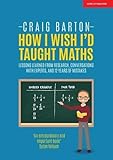Here's the relevant bit:
---------
Guided discovery lesson plans can be found on most topics in maths. Geometry is a particularly fertile breeding ground. Take something like circle theorems. Instead of simply explaining to students the Angle at the Centre relationship, why not have them discover it for themselves? Give them a set of blank circles, instructions to construct several formulations of the theorem, each time giving them complete freedom as to where they place their three points on the circumference, challenge them to measure the two relevant angles and then see what they notice. Students get important practice of measuring angles, a feeling of involvement in their own learning, and may even teach themselves a key GCSE topic without me needing to say a word. What could possibly go wrong?
I was particularly proud of a guided discovery task I came up with for introducing some of the more complex laws of indices to my Year 11 class two years ago. The worksheet looked like this:
https://drive.google.com/file/d/1PfJjT058t55C_LR8LE1D3PaSRg9...
Nice, eh? Again, I ask the question: what could possibly go wrong? Well, quite a lot, as it turns out.
Take the laws of indices lesson. The best that can happen is that all students discover the laws of indices for themselves, leaving no gaps in their knowledge, nor developing any misconceptions, in a reasonable time frame. We can then proceed with the rest of the lesson, maybe moving on to application questions, or interleaving other topics into the examples (see Chapter 12), such as indices involving surds or fractions. How often does that actually happen? In my experience, literally never. What actually happens is that one or two students discover exactly what I wanted them to discover. They are feeling great about themselves, and rightly so –as we have seen in Chapter 2, success is motivating. A handful of students have some kind of idea what is going on, but with an eclectic mix of gaps in their knowledge and newly formed misconceptions. Some of these students are aware they have gaps and misconceptions, others are blissfully ignorant. And the rest of the students do not have a flipping clue what is going on. They are feeling confused and pretty down about themselves when they see their fellow classmates have figured it out. Any form of decent formative assessment strategy (Chapter 11) quickly reveals this disparity between levels of understanding, and as such I cannot move on with the lesson. So what do I inevitably end up doing? Teaching the laws of indices, of course! Maybe I will set those students who seem to have understood it off on the work I hoped everyone else would be moving on to –mind you, I would really like them to hear my explanation and do the worked examples, but how can I justify doing so when they have demonstrated their understanding? Hmmm…
Anyway, back to the rest of the class. By this stage, I am 30 minutes into a 50-minute lesson, rattling through a series of worked examples on the laws of indices far quicker and with much less care than I should. There is zero time for the students to practise their newly acquired skills and hence consolidate their knowledge, nor sufficient time for me to do any kind of application questions which would show them the full breadth of the topic.
But it is even worse than that. Even if I could somehow freeze time and spend those lost 30 minutes going through carefully structured and well-chosen worked examples, I am not back at square one. I am behind square one, because my students are no longer coming at the topic with fresh eyes. Many of those who failed to ‘discover’ the key relationships have already decided that indices are difficult, and yet another area of maths that they don’t understand. It’s going to take more than my magically retrieved 30 minutes to turn that one around.
--------
Later the author describes how his approach has now changed to direct guidance. Of this approach he writes:
A common complaint I hear from teachers when I describe this approach is that students are not as actively involved as they would be during guided discovery. My response is that it depends on what you mean by active, and its anthesis, passive. If active students are ones making noise, working in groups, moving around the classroom, going about the task several different ways, getting some things right but plenty of things wrong, whereas passive students are sitting there quietly, thinking hard about the mathematics I am presenting, then I know which one I would prefer, especially at this early knowledge acquisition stage. For me, such ‘activity’ is exactly the poor proxy for learning that Coe (2013) warns us about. Students may well be active, but active doing what? What are they thinking about? What are they expanding their precious, limited working memory reserves on? During these demonstrations, my students are active in another sense. They are actively thinking hard about the matter in hand – or at least I am creating conditions to give them the very best chance of thinking hard about the matter in hand, and nothing else. Such activity is impossible to see, hence it is often dismissed as passivity and a lack of engagement. But periods of quiet contemplation like this are the key to learning, especially when we consider in greater depth the limits of working memory
1] https://www.amazon.com/How-Wish-Taught-Maths-conversations/d...


Long version (about math, but with specific, non-trivial recommendations that obviously generalize to some extent): https://www.amazon.com/How-Wish-Taught-Maths-conversations/d...
Another HN commenter suggested the book to me recently. It's really good, and gives copious citations. Some gripes: It's way too long, and there are a handful of things I feel are better explained elsewhere (e.g. the "good" example used when talking about how to label diagrams I feel is actually bad...).